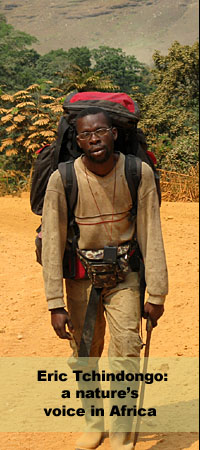|
Eric Tchindongo is a conservationist born in the hearth of the rainforest at Conkouati National Park in the Republic of the Congo. He studied geography and environment at the university and then went back to his home to save endangered animals and rainforest. He worked with local non-profit organizations and is currently engaged with the Jane Goodall Institute and Endangered Species International (ESI).
ESI:
You are Congolese, how did you develop this passion for nature in the hearth of Central Africa?
Tchindongo:
Well, I was born and raised in the Conckouati National Park meaning I spent a lot time living in close relationship with nature. I have developed a special affinity with rainforest and wildlife. I studied geography at the university and then I went back to my natal land working for chimpanzees for two nonprofit organizations: Help Congo and the Jane Goodall Institute. I love nature and I want to contribute to healthier planet.
ESI:
Do you observe gorillas from time to time while you are in the field?
Tchindongo:
I saw them in the area of Domonika in the southern part of the country, but it is getting more difficult every day to observe them because illegal hunting of gorillas occurs heavily in the region. I have not seen any for a while now. In the Mayombe area, gorillas are confined to places where hunting is less prevalent like at higher altitudes.
ESI:
In your opinion, how can we stop the illegal killing of gorillas for bushmeat trade as recently documented by ESI?
Tchindongo:
We must and can stop bushmeat trade of gorillas by addressing the root factors threatening them. In general, some forest ethnics eat gorilla meat but not all. The Yombe tribe native to Mayombe used to avoid killing gorillas because it was against their cultural beliefs. Then, immigrants came into the forest and influenced traditional culture. Immigrants introduced the consumption of gorillas. Gorillas are also hunted for food because many others wildlife species are very rare. In markets, gorilla meat is sold as buffalo meat to avoid potential law enforcement issues. We need to educate local people about the Ebola virus and its great danger to human health. We need to put back the ancestral habits and customs at the forefront of our culture and to consider great apes as tutelary ancestors.
ESI:
What are the main barriers to conservation in the Republic of Congo?
Tchindongo:
Barriers to conservation are social and institutional. Nature conservation is present in many ethnic groups but the influence of Christianity in the Republic of the Congo has devaluated the role of wildlife. Also, there is a need to better understand the environment laws at the local level and to fight corruption that allows unlawful practices against nature.
ESI:
Can you give us one or two recent examples showing positive actions in protecting nature in the Republic of the Congo?
Tchindongo:
At the governmental level, “le ministère de l'économie forestière” has launched in 2006 a program to inventory biodiversity to better protect biodiversity. It is still at the primarily stage and there is an important lack of resources but I have hope on that! The Mayombe Forest Transborder Initiative is another conservation example where three governments (the Republic of the Congo, Democratic Republic of the Congo, and Angola) are taking the initiative to protect the Mayombe forest which is a biodiversity hotspot.
ESI:
What do you think about ESI in the Republic of the Congo?
Tchindongo:
ESI can have an great role in the Republic of the Congo because it can strengthen conservation and sustainable development. ESI finds different solutions to stem biodiversity loss. By engaging in strong collaboration with local communities in the most remote places, change in behavior is more likely to occur and gorillas are more likely to be left at peace in rainforest. ESI is also effective in sharing knowledge and expertise with locals that then become leaders and practitioners to save gorillas and other endangered species. I can only express my joy to be part of ESI!
ESI:
Thank you and keep up the good work!
|









